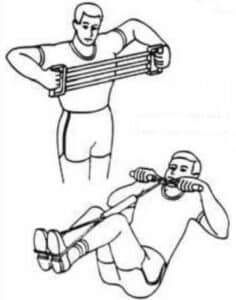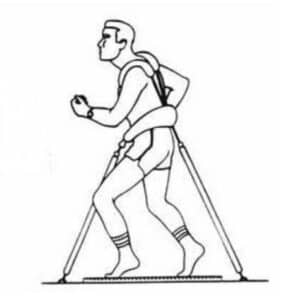Overview
STEM careers
Grade level
Time
Materials
Per Team of 5 Students:
- Rubber bands
- Springs
- Paper cups
- Wooden dowels
- String
- Cloth
- Pulleys
- Paper and pencils
- Elastic cord
- Bicycle tire tubing
- Metal washers
- Eyelet screws
Instructions
 Students invent a model of an exercise machine that would help astronauts maintain muscle and bone mass in space.
Students invent a model of an exercise machine that would help astronauts maintain muscle and bone mass in space.
- Organize students into teams and explain the challenge. Note that students can attach their contraptions to desks, chairs, door knobs, or wall hooks in order to anchor their models and create resistance.
- Discuss the criteria:
- The design has to be original to the team.
- It should be a model (or full-size, depending on materials available); the model should demonstrate the working principles of the design.
- The model should demonstrate the types of exercise astronauts engage in and compare them to similar exercises on Earth.
 The team needs to demonstrate the model for the class.
The team needs to demonstrate the model for the class.
- Give students time to plan and create their exercise models.
- Ask each team to demonstrate its model.
- Ask the class to vote:
- Which product, when full size, would be most compact?
- Which product, when full size, exercises the most muscle groups?
- Which product, when full size, produces the best workout in the shortest time?
Guiding questions
-
What exercise aids used on Earth could be adapted to use in space?
-
How can your exercise device create resistance, so important to strengthening muscles, in the absence of gravity?
-
How can your device be altered to consume more energy?
Engineering & science connections
- Many people mistakenly think astronauts float around in space because gravity does not exist there. However, most spaceflights orbit between 120–360 miles above Earth’s surface, where gravity is still quite strong—that’s what holds them in orbit! Orbiting astronauts and the spaceship they are in move at the same velocity, creating a type of freedom from gravitational direction called microgravity.
- Microgravity can also be found on Earth and occurs whenever an object is in free fall. You can experience moments of microgravity on airplanes, roller coasters, free fall rides, and even when jumping on a trampoline!
- Extended periods of time in microgravity weakens muscles and bones because the amount of weight that bones must support is reduced to nearly zero. Astronauts lose bone mass at a rate of 1–2 percent per month while in space.
- In order to maintain muscle density, muscles must work against a force. On earth, gravity is the natural pulling force which requires us to resist the ground. Out in space where conditions do not cause the same effect, astronauts must use resistive types of exercise equipment such as elastic ropes and bands to help muscles keep their strength and volume.
- Engineers and physicians at NASA have developed a special exercise machine for use during prolonged stays in the International Space Station (ISS). This device mainly uses vacuums to create resistance. Astronauts have nicknamed it “The Beast.”
This activity was developed by the Total Learning Research Institute in cooperation with the Junior Engineering Technical Society.


0 Comments